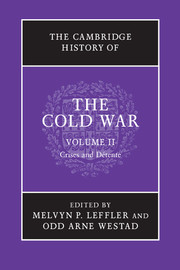Book contents
- Frontmatter
- 1 Grand strategies in the Cold War
- 2 Identity and the Cold War
- 3 Economic aspects of the Cold War, 1962–1975
- 4 The Cuban missile crisis
- 5 Nuclear competition in an era of stalemate, 1963–1975
- 6 US foreign policy from Kennedy to Johnson
- 7 Soviet foreign policy, 1962–1975
- 8 France, “Gaullism,” and the Cold War
- 9 European integration and the Cold War
- 10 Détente in Europe, 1962–1975
- 11 Eastern Europe: Stalinism to Solidarity
- 12 The Cold War and the transformation of the Mediterranean, 1960–1975
- 13 The Cold War in the Third World, 1963–1975
- 14 The Indochina wars and the Cold War, 1945–1975
- 15 The Cold War in the Middle East: Suez crisis to Camp David Accords
- 16 Cuba and the Cold War, 1959–1980
- 17 The Sino-Soviet split
- 18 Détente in the Nixon–Ford years, 1969–1976
- 19 Nuclear proliferation and non-proliferation during the Cold War
- 20 Intelligence in the Cold War
- 21 Reading, viewing, and tuning in to the Cold War
- 22 Counter-cultures: the rebellions against the Cold War order, 1965–1975
- 23 The structure of great power politics, 1963–1975
- 24 The Cold War and the social and economic history of the twentieth century
- Bibliographical essay
- Index
- References
20 - Intelligence in the Cold War
Published online by Cambridge University Press: 28 September 2010
- Frontmatter
- 1 Grand strategies in the Cold War
- 2 Identity and the Cold War
- 3 Economic aspects of the Cold War, 1962–1975
- 4 The Cuban missile crisis
- 5 Nuclear competition in an era of stalemate, 1963–1975
- 6 US foreign policy from Kennedy to Johnson
- 7 Soviet foreign policy, 1962–1975
- 8 France, “Gaullism,” and the Cold War
- 9 European integration and the Cold War
- 10 Détente in Europe, 1962–1975
- 11 Eastern Europe: Stalinism to Solidarity
- 12 The Cold War and the transformation of the Mediterranean, 1960–1975
- 13 The Cold War in the Third World, 1963–1975
- 14 The Indochina wars and the Cold War, 1945–1975
- 15 The Cold War in the Middle East: Suez crisis to Camp David Accords
- 16 Cuba and the Cold War, 1959–1980
- 17 The Sino-Soviet split
- 18 Détente in the Nixon–Ford years, 1969–1976
- 19 Nuclear proliferation and non-proliferation during the Cold War
- 20 Intelligence in the Cold War
- 21 Reading, viewing, and tuning in to the Cold War
- 22 Counter-cultures: the rebellions against the Cold War order, 1965–1975
- 23 The structure of great power politics, 1963–1975
- 24 The Cold War and the social and economic history of the twentieth century
- Bibliographical essay
- Index
- References
Summary
Intelligence is probably the least understood aspect of the Cold War, sometimes sensationalised, often ignored. It is also the only profession in which a fictional character is far better known than any real practitioner, alive or dead. Cold War intelligence was, of course, not usually as exciting as the career of James Bond. Like all forms of information, the impact of intelligence is more often gradual than dramatic – though it does from time to time suddenly produce such spectacular revelations as the Soviet acquisition of the plans of the first US atomic bomb or the Soviet construction of missile sites in Cuba in 1962. Sometimes intelligence adds information of real importance to what is available from more conventional sources. Sometimes it adds little or nothing. But, whether intelligence is used, abused or simply ignored, historians of the Cold War can never afford to disregard it. The many studies of policy-making in East and West which fail to take intelligence into account are at best incomplete, at worst distorted.
Signals intelligence (SIGINT)
The starting point for any attempt to assess the role of intelligence during the Cold War is to recognise how much we still do not know. Signals intelligence is perhaps the prime example. Though SIGINT was far more voluminous than intelligence from human sources (HUMINT), it is still entirely absent from most histories of the Cold War. At the end of the Second World War, GCHQ (the British SIGINT agency) wanted to keep secret indefinitely the wartime ULTRA intelligence derived from breaking the German Enigma and other high-grade enemy ciphers but expected the secret to be uncovered within a few years.
- Type
- Chapter
- Information
- The Cambridge History of the Cold War , pp. 417 - 437Publisher: Cambridge University PressPrint publication year: 2010
References
- 2
- Cited by

